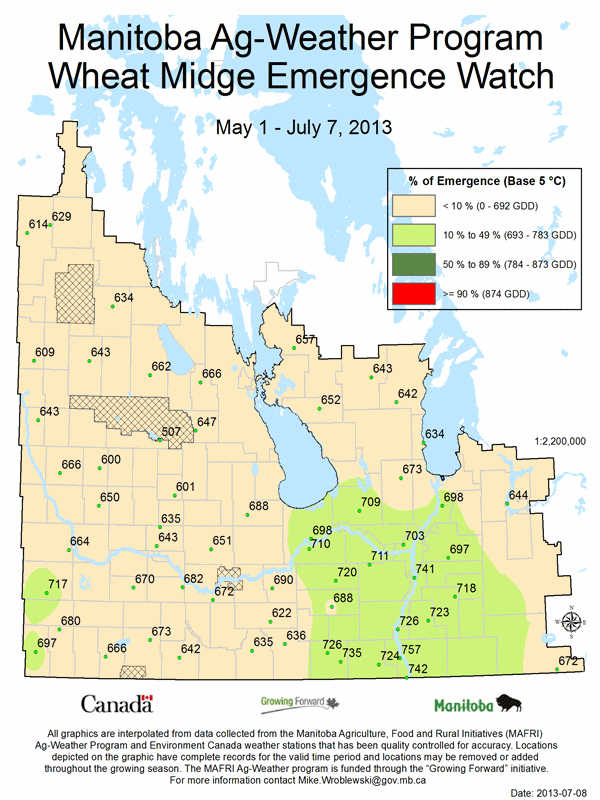Manitoba Insect and Disease Update: Week of July 8, 2013
Compiled by:
- John Gavloski, Entomologist
Manitoba Agriculture, Food and Rural Initiatives
Phone: (204) 745-5668
Fax: (204) 745-5690. - Holly Derksen, Plant Pathologist
Manitoba Agriculture, Food and Rural Initiatives
Phone: (204) 750-4248
Fax: (204) 745-5690
To report observations on insects or plant pathogens that may be of interest or importance to farmers and agronomists in Manitoba, please send messages to the above contact address.
To be placed on an E-mail list so you will be notified immediately when new Manitoba Insect and Disease Updates are posted, please contact John Gavloski at the address or numbers listed above.
Recent Insect and Plant Pathogen Activity
Grasshoppers:
Grasshoppers continue to be a problem, and insecticides are being applied in some areas, in many instances around field edges.
If you observe the grasshoppers currently present you will notice that they are still nymphs, we are not seeing adult grasshoppers yet. Some have wing buds (their wings are developing but not yet to the stage where they can fly) and in some the wing buds are not yet visible. So they are not flying yet and populations will still be somewhat concentrated.
Some grasshopper facts that might be helpful:
Do they have food preferences? There are some crops that are less preferred as food sources. Oats and peas are two such crops. Other crops are preferred over these, so feeding is usually less, and if they do feed on oats or peas their reproductive potential is less.
Tips for assessing grasshopper populations: Making decisions regarding whether grasshopper populations may be economical can be tricky. Suggested thresholds, as posted in last weeks update, are based on estimates per square meter. Note that these are estimates, it is impossible to do very accurate counts when populations are high and the grasshoppers are moving as you walk through the crop or field edge. You are essentially trying to determine which range of numbers (8-14/m2, 15-28, etc.) best represents the grasshopper population that is present. If you have a sweep net, you could try to catch a few and determine the stage and species present.
Blackleg:
A couple of fields with severe infections of blackleg have been reported in the province. The easiest time to scout for blackleg basal lesions is at or after swathing when stems can be cut open and blackleg can be easily distinguished from other issues. At earlier stages in canola, it is difficult to determine whether the issue you are seeing in canola is due to blackleg or a number of other causes, such as root rot, insect damage, or environmental stresses. Symptoms of basal blackleg at this stage may include lodged plants and stems that are pinched off at the soil line and will likely break off when pulled. Blackleg leaf lesions are easily identifiable at this stage, but this disease is only a concern when the infection moves to the stem. For more information on blackleg visit the MAFRI website, Blackleg in Canola.
Surveys and Forecasts
Bertha Armyworm:
The cumulative counts are still generally within the low risk zone, however some traps in the Central and Eastern regions of Manitoba are in the uncertain risk zone. A trap in the Elm Creek area has a cumulative count of 938 moths, and is in the moderate risk category.
Trap counts are an indication of the risk within a general region, and hence the importance of looking for larvae on the ground when scouting canola fields. Traps do not necessarily indicate risk in the specific field the trap is in, as factors such as crop staging and how attractive to crops are to the egg-laying females will affect which fields within a region may have higher levels of larvae.
Highest cumulative trap counts to date are:
Risk of bertha armyworm based on moth capture in pheromone-baited traps
0-300 = Low risk 300-900= Uncertain risk 900-1,200= Moderate risk 1,200+= High risk | |
|---|---|
| Location | Total Count |
| Elm Creek | 938 M |
| Sperling | 667 U |
| Carberry | 512 U |
| Glenboro | 341 U |
| Ridgeville | 327 U |
A table showing data from the bertha armyworm monitoring program can be viewed on the MAFRI website at:
Wheat Midge
Degree day (DD) models using a base temperature of 5C can be used to estimate the emergence of adult wheat midge. The map as of July 7th showed that emergence has started (10 - 49%) in the Red River valley and some areas of western Manitoba. For the rest of Manitoba emergence is less than 10%.
Note that wheat is only susceptible to wheat midge from the time heads are first visible until flowering (when anthers are visible). In many wheat fields the heads may already be producing anthers. In these fields the crop is already resistant to feeding by wheat midge, and will have flowered before wheat midge emergence peaked.

Parasitoid of Wheat Midge (Macroglenes penetrans)
Degree days can also be using to estimate the emergence of Macroglenes penetrans, the main parasitoid of wheat midge. There should be greater than 90% emergence of Macroglenes penetrans over most of the agricultural area of Manitoba. So when the wheat midge do emerge the parasitoids will be ready and waiting.
